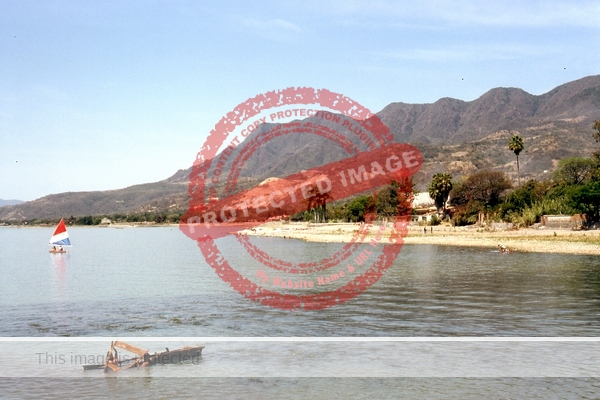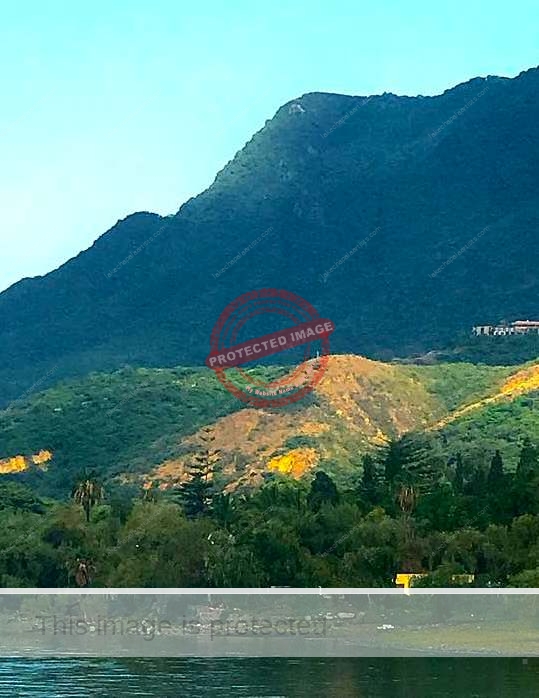Though I didn’t realize it at the time, a photo I took of Ajijic in 1980 (below) shows, almost precisely in the middle, the bare hillside known as Cerro del Aguila (“Hill of the Eagle”) or Cerro Colorado (“Colored Hill”). According to a local legend, the hillside was formed during the centuries-long migration of the Mexica people (the forerunners of the Aztecs) from their ancestral homeland, Aztlán, en route to founding their capital city, Tenochtitlan (where Mexico City stands today) in 1325.
The Mexica were looking for a sign—an eagle perched on a prickly pear cactus—to tell them where to found their new capital and ceremonial center. Today, this sign, with the addition of a serpent, which the eagle is devouring, is a national symbol and appears on the national flag.

Ajijic and its eagle. © Tony Burton, 1980.
The Ajijic version of the legend was summarized in 1988 by journalist Ruth Netherton, a long-time Ajijic resident. She explained to her readers that the Mexica saw their sign at Lake Chapala’s Isla de los Alacranes:
As the priests pondered the omen, a strong wind blew up and dashed the eagle against a barren hill, leaving its image there. The eagle is still visible today above Rancho del Oro, with wings outstretched, a shrub forming the eye. Why the priests were discouraged from founding Tenochtitlan at Lake Chapala is not explained. Perhaps the strong wind (called locally “el abajeño” or “el mexicano”) was considered a bad omen.”
This is an appealing legend, and one which directly links Ajijic to the rise of the Aztec Empire. But the unanswered question about this legend is just how old it might be. Did the legend start when Ajijic was founded in 1531? Is it possible to trace its origin back that far, or even further?

Ajijic: Cerro del Aguila. © John Spillyards. 2023. Image reproduced courtesy of the photographer.
In my thirty-plus years of research about Lake Chapala, I have come across remarkably few references to the Ajijic Eagle, and none of them date back very far. The earliest documentary evidence I’ve come across is a paragraph written by Dr Leo Stanley in October 1937, when he and and a friend rode horseback from Chapala to Jocotepec, and then continued along the southern shore of the lake to San Luis [Soyutlán], where they found lodgings for the night. In the early evening, Stanley strolled down to the lake shore:
It was a very pretty afternoon, and off in the distance across the lake toward San Juan could be seen a peculiar phenomenon. By landslides and erosions in the mountains, the natural form of a spread eagle was displayed in brown against the green verdure. This marking could be seen very distinctly from the southern shore of the lake.”
On the other hand, none of the three best-known books about the Ajijic area written a decade later—House in the Sun and Village in the Sun, both by ‘Dane Chandos (Peter Lilley and Nigel Millett), and Dust on my Heart, by Neill James— includes any mention or description of the Ajijic Eagle.
This leads me to believe that, even though the Mexica migration legend is ancient, its link to the Ajijic eagle is much more recent, perhaps dating from the beginning of the twentieth century, and associated with several decades of mining in the hills behind Ajijic. For example, just before the Mexican Revolution erupted in 1910, we know that the owners of one of the main mines were installing “a cyanide annex at the plant, which now consists of ten-stamp concentrators and amalgamating plates.” The use of cyanide on this scale would have killed off the immediate vegetation and destroyed soil organisms, creating a barren area that has remained infertile to this day: the unusual eagle-shaped hillside scar on Cerro Colorado.
If you know of other literary or documentary references to the Ajijic Eagle, please let me know!
Several chapters of Foreign Footprints in Ajijic: Decades of Change in a Mexican Village offer more details about the history of mining, artists and authors in Ajijic.
Sources
- The Mexican Herald, 15 December 1909, 15.
- Ruth Netherton. 1988. “Laguna Chapalac.” Guadalajara Reporter, 20 August 1988.
- Leo L. Stanley. 1937. “Mixing in Mexico,” 1937, two volumes. Leo L. Stanley Papers, MS 2061, California Historical Society. Volume 2. (My sincere thanks to Frances Kaplan, Reference & Outreach Librarian of the California Historical Society, and to the California Historical Society for permission to reproduce the excerpt used in this post.)
Comments, corrections and additional material are welcome, whether via the comments feature or email.
Tony Burton’s books include “Lake Chapala: A Postcard History” (2022), “Foreign Footprints in Ajijic” (2022), “If Walls Could Talk: Chapala’s historic buildings and their former occupants” (2020), (available in translation as “Si Las Paredes Hablaran”), “Mexican Kaleidoscope” (2016), and “Lake Chapala Through the Ages” (2008).
Tony: as you know, the cover of “Soledad” has an image of Katie taken in the early 1950’s from the pier and it clearly shows the eagle, even the bush/eyeball. So there is photographic documentation back some 80 years. Was this symbol here 800 years ago, during the mythical migration from the north?
The Ajijic Cultural Center also features a mural (“Venimos de Atzlan”) with locals dissuading invaders (Mexica) from staying here and pointing (it’s assumed) toward the southeast as if to say “You’re not to your promised land and need to move on”. I wonder what accounts the artist used?
I tell this story on my walking tours and find my guests are fascinated by this legend and visual representation. Thanks for sharing!
Greg, Thanks for your comment. Actually, the image on the cover of Soledad is not a photo of Katie Goodridge Ingram, but of her daughter, so dates (I believe) from the early 1970s.
There may well be earlier photographs showing the ‘eagle’ among someone’s family photos, and, if so, I’d love to see them. The Mexica migration legend has a very long history, but suggestions that the migration included a visit or stopover at Lake Chapala (an idea I mentioned in the early pages of “Western Mexico” 30+ years ago) are conjectural. It’s an appealing idea, despite lacking any solid evidence.
It would not be difficult to disprove my suggestion that the ‘eagle’ is the fortuitous result of cyanide contamination, but please take precautions if you plan to take soil samples!
Best, Tony
wow–what a wonderful mystery–I’m wondering what if any changes in last 200 years may have altered or lessened the view–and I’m not stating that well. Oh 30 years back at a little known ruin in northern Veracruz state an unschooled local kid point out to me how the ancients has set the pyramid up to take advantage of some grey/white sheer wall face perhaps a 1/4th mile distant. Not sure I’ve ever seen a degreed archeologist write about the ancients using this type-vision or perspective in locating a temple/pyramid etc. anyway–this eagle view makes me wonder how it may have been used 500 plus years ago when designing other smaller temples in that area if it was indeed visible then–would u see it from a platform in the distance– anyway–thanks for this info and for stimulating my thoughts.–thanks to Greg Custer’s thoughts too–bill